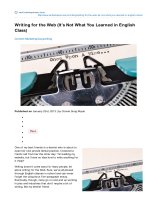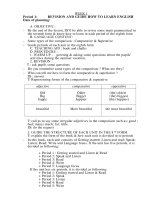Discovering How You Learn
Bạn đang xem bản rút gọn của tài liệu. Xem và tải ngay bản đầy đủ của tài liệu tại đây (87.39 KB, 10 trang )
9
CHAPTER
2
D
ISCOVERING
H
OW
Y
OU
L
EARN
You like surprises and your
friend Harry hates them.
You love movies, but Harry
would rather listen to
music. You like different
things because you think
differently. You and Harry
will probably get more out
of studying if you combine
your different styles.
S
uppose you and your friend Harry are
in an American history class, studying the events that led up to
World War I. Films and tapes of speeches about the period are
in the school library. Since you love movies, you might get more out of
watching the films. Since Harry prefers listening, he might get more out
of listening to speeches. If you were to just listen to the speeches and
Harry were to watch the films, neither of you would fully understand
what you’re studying.
HOW TO STUDY
10
PEOPLE THINK AND LEARN DIFFERENTLY
How do you learn? We all have two eyes, two ears, a nose, but we each
look unique. People aren’t the same on the outside, and they’re not the
same inside either. Everyone has their own learning style. You were born
with yours and Harry was born with his; different parts of everybody’s
brain are—well, different!
Think of a person as a seesaw. It’s pretty unusual for someone to
be a perfectly level seesaw, with all learning styles having the same
strength, or weight. For most of us, the seesaw is tilted. Where it goes up,
we have more learning strength, and where it goes down, we have less. We
tilt one way or another but we all stay in the air because one side
compensates for the other. It’s important to know how you learn best, so
you can do more of what works best for you.
You can find clues about how you learn best by looking for a
similarity in the things you like to do. You learn in many different ways,
and you have your own combinations of learning styles.Usually,you’re
comfortable doing certain activities and you get more out of these
activities because they match your learning styles.
The purpose of this chapter is to help you get in touch with the
styles with which you’re most comfortable. Once you’ve identified these
styles, you can move on to the later chapters that focus on a specific style
of learning.
FIVE LEARNING STYLES
There are five different learning styles. Most people have at least one
dominant style, but everyone uses a combination of learning styles,
sometimes depending on the activity they’re doing.
• Eyes. If you like to watch movies and draw or paint, or get
involved in other activities that rely on your eyes, you are proba-
bly a visual learner. Visual learners mainly use their eyes to learn.
• Ears. If you’d rather listen to the radio than read the paper, if you
like listening to music and/or lectures, or participate in other
activities that depend on your ears, you are probably an auditory
learner. Auditory learners mostly use their ears to learn.
DISCOVERING HOW YOU LEARN
11
• Order. If you like to do crossword puzzles, fill out forms, work
math problems, or do other activities in an orderly way, you are
probably a sequential learner. Sequential learners need to put
things in a particular order so they can learn them.
• Images. If you make pictures or designs in your head as you’re
looking at or listening to something, you are learning through
images. People who learn through images are usually global learn-
ers. These people like to see the whole picture and often don’t
need to work through individual parts, as sequential learners do.
• Doing. If you like to keep moving—whether it’s the big-move-
ment action of sports or dancing, or a small-movement action
such as doodling, playing an instrument, or needlework, you
might learn best by motion, and be a kinesthetic learner.
Kinesthetic learners learn best when they keep their bodies or
hands moving.
G
ET IN
T
OUCH WITH
Y
OUR
S
TYLE
Here’s an activity using five general styles to help you get in touch with
how you learn.
• Write in your notebook a list of things you like to do, and things
you’re good at. Include the kinds of jobs you enjoy, clubs you
belong to or to which you’d like to belong, and things you haven’t
done but wish you could.
• Make five columns, one for each general learning style: eyes, ears,
order, images, and doing.
• Now take each item from your list and put it in the appropriate
column. Some things might appear in more than one column.
For instance, playing the clarinet could be both doing (the fingers
are doing the walking) and ears (listening).
• Add the number of items in each column. Which columns have
the most? These are the ones that most likely represent your
strongest learning styles.
Find Out!
1.
2.
3.
HOW TO STUDY
12
You’ll probably find ways other than these five that are particularly
helpful to you. What’s important is that you keep looking for connections
between what you do and how you do it. There are as many combina-
tions of learning styles as there are people! The way to find out about
yourself is to pay close attention to when and how you pay close attention.
H
OW
D
O
Y
OU
R
EMEMBER
?
The next time someone gives you a phone number, pay attention to what
you do to try to remember the number. Write in your notebook what
you do.
Do you see the numbers in your head?
Do you say the numbers, perhaps over and over, in your head?
Do you do both?
Do you write the numbers in the air with your finger?
Do you make a picture of the numbers in your head?
Do you hear the tones of the numbers in your head?
Do you put the numbers in certain groupings?
Try It!
1.
2.
3.
DISCOVERING HOW YOU LEARN
13
RIGHT-BRAIN VERSUS LEFT-BRAIN THINKING
Another kind of difference in learning styles has to do with whether the
right side or the left side of your brain is dominant. Your brain hemispheres
crisscross to your hands. This means that if you’re left-handed, the right
side of your brain is probably more developed. If you’re right-handed, you
probably rely on the left side of your brain more than the right. Each side
has its own jobs to do, although the two sides do communicate with each
other. You might find traits of how you think in both sides.
Right-brain thinkers (who are usually left-handed) tend to be creative
types. They are good at coming up with new ideas. Many artists, poets, and
composers are right-brain thinkers.
Left-brain thinkers (who are usually right-handed) are more orderly
in their thought processes. There are many more left-brain thinkers than
right-brain thinkers, so you’ll find left-brain thinkers in all kinds of
occupations.
Each kind of thinking has its own strengths. While the right-brain
thinker will come up with a good idea for the theme of a birthday party,
the left-brain thinker is the one you would want to count on to organize
the party: send out the invitations, get the food, and find people to help
decorate. The right-brain thinker will be good at creative games like
charades, while the left-brain thinker will be good at games that require
logic and following rules, like checkers or bridge. The right-brain thinker
loves to dance and may even make up new steps to go with the music.
The left-brain thinker may like to dance, too, because he or she will find
it easy to learn the steps of the waltz, mambo, or electric slide.
Right-brain thinkers like the rhythm of poetry. Left-brain thinkers like
figuring out the meaning of a poem.
As you’ll see in the next section, it matters whether you’re a right-
brain or a left-brain thinker because each kind of thinking requires dif-
ferent kinds of study habits.
So what’s your next step? To find out what kind of thinker you are!
R
IGHT OR
L
EFT
?
Are you left-handed (right brain) or right-handed (left brain)? This will
give you a clue, but a lot of left-handed people have some left-brain ten-
Find Out!
Find Out!









